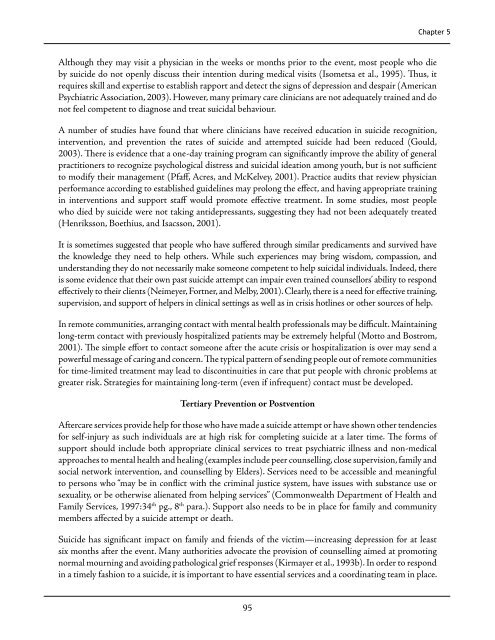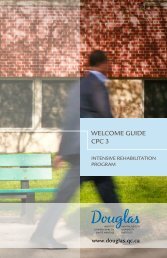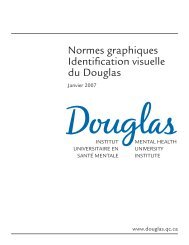Suicide Among Aboriginal People in Canada - Institut universitaire ...
Suicide Among Aboriginal People in Canada - Institut universitaire ...
Suicide Among Aboriginal People in Canada - Institut universitaire ...
You also want an ePaper? Increase the reach of your titles
YUMPU automatically turns print PDFs into web optimized ePapers that Google loves.
Chapter 5Although they may visit a physician <strong>in</strong> the weeks or months prior to the event, most people who dieby suicide do not openly discuss their <strong>in</strong>tention dur<strong>in</strong>g medical visits (Isometsa et al., 1995). Thus, itrequires skill and expertise to establish rapport and detect the signs of depression and despair (AmericanPsychiatric Association, 2003). However, many primary care cl<strong>in</strong>icians are not adequately tra<strong>in</strong>ed and donot feel competent to diagnose and treat suicidal behaviour.A number of studies have found that where cl<strong>in</strong>icians have received education <strong>in</strong> suicide recognition,<strong>in</strong>tervention, and prevention the rates of suicide and attempted suicide had been reduced (Gould,2003). There is evidence that a one-day tra<strong>in</strong><strong>in</strong>g program can significantly improve the ability of generalpractitioners to recognize psychological distress and suicidal ideation among youth, but is not sufficientto modify their management (Pfaff, Acres, and McKelvey, 2001). Practice audits that review physicianperformance accord<strong>in</strong>g to established guidel<strong>in</strong>es may prolong the effect, and hav<strong>in</strong>g appropriate tra<strong>in</strong><strong>in</strong>g<strong>in</strong> <strong>in</strong>terventions and support staff would promote effective treatment. In some studies, most peoplewho died by suicide were not tak<strong>in</strong>g antidepressants, suggest<strong>in</strong>g they had not been adequately treated(Henriksson, Boethius, and Isacsson, 2001).It is sometimes suggested that people who have suffered through similar predicaments and survived havethe knowledge they need to help others. While such experiences may br<strong>in</strong>g wisdom, compassion, andunderstand<strong>in</strong>g they do not necessarily make someone competent to help suicidal <strong>in</strong>dividuals. Indeed, thereis some evidence that their own past suicide attempt can impair even tra<strong>in</strong>ed counsellors’ ability to respondeffectively to their clients (Neimeyer, Fortner, and Melby, 2001). Clearly, there is a need for effective tra<strong>in</strong><strong>in</strong>g,supervision, and support of helpers <strong>in</strong> cl<strong>in</strong>ical sett<strong>in</strong>gs as well as <strong>in</strong> crisis hotl<strong>in</strong>es or other sources of help.In remote communities, arrang<strong>in</strong>g contact with mental health professionals may be difficult. Ma<strong>in</strong>ta<strong>in</strong><strong>in</strong>glong-term contact with previously hospitalized patients may be extremely helpful (Motto and Bostrom,2001). The simple effort to contact someone after the acute crisis or hospitalization is over may send apowerful message of car<strong>in</strong>g and concern. The typical pattern of send<strong>in</strong>g people out of remote communitiesfor time-limited treatment may lead to discont<strong>in</strong>uities <strong>in</strong> care that put people with chronic problems atgreater risk. Strategies for ma<strong>in</strong>ta<strong>in</strong><strong>in</strong>g long-term (even if <strong>in</strong>frequent) contact must be developed.Tertiary Prevention or PostventionAftercare services provide help for those who have made a suicide attempt or have shown other tendenciesfor self-<strong>in</strong>jury as such <strong>in</strong>dividuals are at high risk for complet<strong>in</strong>g suicide at a later time. The forms ofsupport should <strong>in</strong>clude both appropriate cl<strong>in</strong>ical services to treat psychiatric illness and non-medicalapproaches to mental health and heal<strong>in</strong>g (examples <strong>in</strong>clude peer counsell<strong>in</strong>g, close supervision, family andsocial network <strong>in</strong>tervention, and counsell<strong>in</strong>g by Elders). Services need to be accessible and mean<strong>in</strong>gfulto persons who “may be <strong>in</strong> conflict with the crim<strong>in</strong>al justice system, have issues with substance use orsexuality, or be otherwise alienated from help<strong>in</strong>g services” (Commonwealth Department of Health andFamily Services, 1997:34 th pg., 8 th para.). Support also needs to be <strong>in</strong> place for family and communitymembers affected by a suicide attempt or death.<strong>Suicide</strong> has significant impact on family and friends of the victim—<strong>in</strong>creas<strong>in</strong>g depression for at leastsix months after the event. Many authorities advocate the provision of counsell<strong>in</strong>g aimed at promot<strong>in</strong>gnormal mourn<strong>in</strong>g and avoid<strong>in</strong>g pathological grief responses (Kirmayer et al., 1993b). In order to respond<strong>in</strong> a timely fashion to a suicide, it is important to have essential services and a coord<strong>in</strong>at<strong>in</strong>g team <strong>in</strong> place.95
















